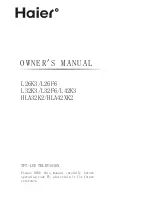
50
LC-39/50LE750
LC-39/50LE751
LC-39/50LE752
IC 3501, IC3502 & IC 3503:
2Gb 16Bits DDR3-1600 SDRAM
Part number: MT41J128M16JT-125:K (MICRON)
Sharp code: RH-IXD538WJZZQ
http://www.micron.com/~/media/Documents/Products/Data%20Sheet/DRAM/2Gb_DDR3_SDRAM.pdf
DDR3 SDRAM uses double data rate architecture to achieve high-speed operation. The double data rate architecture is an 8n-
prefetch architecture with an interface designed to transfer two data words per clock cycle at the I/O pins. A single read or write
operation for the DDR3 SDRAM effectively consists of a single 8n-bit-wide, four-clock cycle data transfer at the internal
DRAM core and eight corresponding n-bit-wide, one half-clock-cycle data transfers at the I/O pins. The differential data strobe
(DQS, DQS#) is transmitted externally, along with data, for use in data capture at the DDR3 SDRAM input receiver. DQS is
center-aligned with data for WRITEs. The read data is transmitted by the DDR3 SDRAM and edge-aligned to the data strobes.
The DDR3 SDRAM operates from a differential clock (CK and CK#). The crossing of CK going HIGH and CK# going LOW is
referred to as the positive edge of CK. Control, command, and address signals are registered at every positive edge of CK. Input
data is registered on the first rising edge of DQS after the WRITE preamble, and output data is referenced on the first rising edge
of DQS after the READ preamble.
Read and write accesses to the DDR3 SDRAM are burst-oriented. Accesses start at a selected location and continue for a
programmed number of locations in a programmed sequence. Accesses begin with the registration of an ACTIVATE command,
which is then followed by a READ or WRITE command. The address bits registered coincident with the ACTIVATE command
are used to select the bank and row to be accessed. The address bits registered coincident with the READ or WRITE commands
are used to select the bank and the starting column location for the burst access.
The device uses a READ and WRITE BL8 and BC4. An auto precharge function may be enabled to provide a self-timed row
precharge that is initiated at the end of the burst access.
As with standard DDR SDRAM, the pipelined, multibank architecture of DDR3 SDRAM allows for concurrent operation,
thereby providing high bandwidth by hiding row precharge and activation time.
A self refresh mode is provided, along with a power-saving, power-down mode.
Features:
VDD = VDDQ = 1.5V ±0.075V. 1.5V center-terminated push/pull I/O.
Differential bidirectional data strobe with 8n-bit prefetch architecture.
Differential clock inputs (CK, CK#).
8 internal banks.
Nominal and dynamic on-die termination (ODT) for data, strobe, and mask signals.
Programmable CAS READ latency (CL). Posted CAS additive latency (AL).
Programmable CAS WRITE latency (CWL) based on tCK.
Fixed burst length (BL) of 8 and burst chop (BC) of 4 (via the mode register set [MRS]).
Self refresh temperature (SRT).
Multipurpose register with Output driver calibration.
MAJOR ICs INFORMATION ( continued )
















































